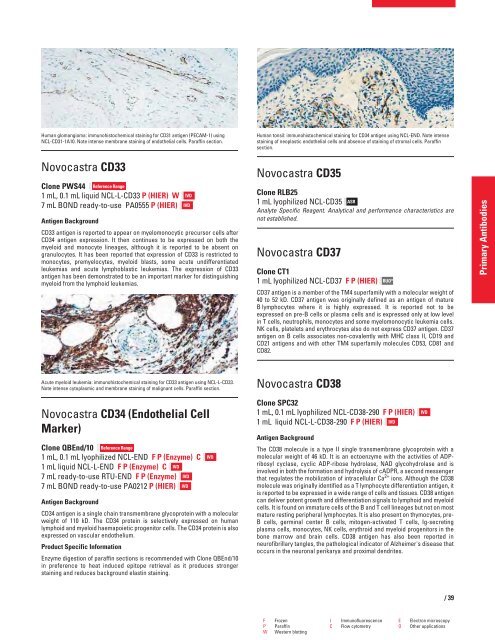QF0159 Marketing Release Record
QF0159 Marketing Release Record
QF0159 Marketing Release Record
You also want an ePaper? Increase the reach of your titles
YUMPU automatically turns print PDFs into web optimized ePapers that Google loves.
Human glomangioma: immunohistochemical staining for CD31 antigen (PECAM-1) using<br />
NCL-CD31-1A10. Note intense membrane staining of endothelial cells. Paraffin section.<br />
Novocastra CD33<br />
Clone PWS44 Reference Range<br />
1 mL, 0.1 mL liquid NCL-L-CD33 P (HIER) W<br />
7 mL BOND ready-to-use PA0555 P (HIER)<br />
Antigen Background<br />
CD33 antigen is reported to appear on myelomonocytic precursor cells after<br />
CD34 antigen expression. It then continues to be expressed on both the<br />
myeloid and monocyte lineages, although it is reported to be absent on<br />
granulocytes. It has been reported that expression of CD33 is restricted to<br />
monocytes, premyelocytes, myeloid blasts, some acute undifferentiated<br />
leukemias and acute lymphoblastic leukemias. The expression of CD33<br />
antigen has been demonstrated to be an important marker for distinguishing<br />
myeloid from the lymphoid leukemias.<br />
Acute myeloid leukemia: immunohistochemical staining for CD33 antigen using NCL-L-CD33.<br />
Note intense cytoplasmic and membrane staining of malignant cells. Paraffin section.<br />
Novocastra CD34 (Endothelial Cell<br />
Marker)<br />
Clone QBEnd/10 Reference Range<br />
1 mL, 0.1 mL lyophilized NCL-END F P (Enzyme) C<br />
1 mL liquid NCL-L-END F P (Enzyme) C IVD<br />
7 mL ready-to-use RTU-END F P (Enzyme) IVD<br />
7 mL BOND ready-to-use PA0212 P (HIER) IVD<br />
Antigen Background<br />
CD34 antigen is a single chain transmembrane glycoprotein with a molecular<br />
weight of 110 kD. The CD34 protein is selectively expressed on human<br />
lymphoid and myeloid haemapoietic progenitor cells. The CD34 protein is also<br />
expressed on vascular endothelium.<br />
Product Specific Information<br />
Enzyme digestion of paraffin sections is recommended with Clone QBEnd/10<br />
in preference to heat induced epitope retrieval as it produces stronger<br />
staining and reduces background elastin staining.<br />
IVD<br />
IVD<br />
IVD<br />
Human tonsil: immunohistochemical staining for CD34 antigen using NCL-END. Note intense<br />
staining of neoplastic endothelial cells and absence of staining of stromal cells. Paraffin<br />
section.<br />
Novocastra CD35<br />
Clone RLB25<br />
1 mL lyophilized NCL-CD35 ASR<br />
Analyte Specific Reagent. Analytical and performance characteristics are<br />
not established.<br />
Novocastra CD37<br />
Clone CT1<br />
1 mL lyophilized NCL-CD37 F P (HIER)<br />
CD37 antigen is a member of the TM4 superfamily with a molecular weight of<br />
40 to 52 kD. CD37 antigen was originally defined as an antigen of mature<br />
B lymphocytes where it is highly expressed. It is reported not to be<br />
expressed on pre-B cells or plasma cells and is expressed only at low level<br />
in T cells, neutrophils, monocytes and some myelomonocytic leukemia cells.<br />
NK cells, platelets and erythrocytes also do not express CD37 antigen. CD37<br />
antigen on B cells associates non-covalently with MHC class II, CD19 and<br />
CD21 antigens and with other TM4 superfamily molecules CD53, CD81 and<br />
CD82.<br />
Novocastra CD38<br />
Clone SPC32<br />
1 mL, 0.1 mL lyophilized NCL-CD38-290 F P (HIER)<br />
1 mL liquid NCL-L-CD38-290 F P (HIER) IVD<br />
Antigen Background<br />
RUO*<br />
The CD38 molecule is a type II single transmembrane glycoprotein with a<br />
molecular weight of 46 kD. It is an ectoenzyme with the activities of ADPribosyl<br />
cyclase, cyclic ADP-ribose hydrolase, NAD glycohydrolase and is<br />
involved in both the formation and hydrolysis of cADPR, a second messenger<br />
that regulates the mobilization of intracellular Ca 2+ ions. Although the CD38<br />
molecule was originally identified as a T lymphocyte differentiation antigen, it<br />
is reported to be expressed in a wide range of cells and tissues. CD38 antigen<br />
can deliver potent growth and differentiation signals to lymphoid and myeloid<br />
cells. It is found on immature cells of the B and T cell lineages but not on most<br />
mature resting peripheral lymphocytes. It is also present on thymocytes, pre-<br />
B cells, germinal center B cells, mitogen-activated T cells, Ig-secreting<br />
plasma cells, monocytes, NK cells, erythroid and myeloid progenitors in the<br />
bone marrow and brain cells. CD38 antigen has also been reported in<br />
neurofibrillary tangles, the pathological indicator of Alzheimer's disease that<br />
occurs in the neuronal perikarya and proximal dendrites.<br />
F Frozen I Immunofluorescence E Electron microscopy<br />
P Paraffin C Flow cytometry O Other applications<br />
W Western blotting<br />
IVD<br />
/39<br />
Primary Antibodies
















